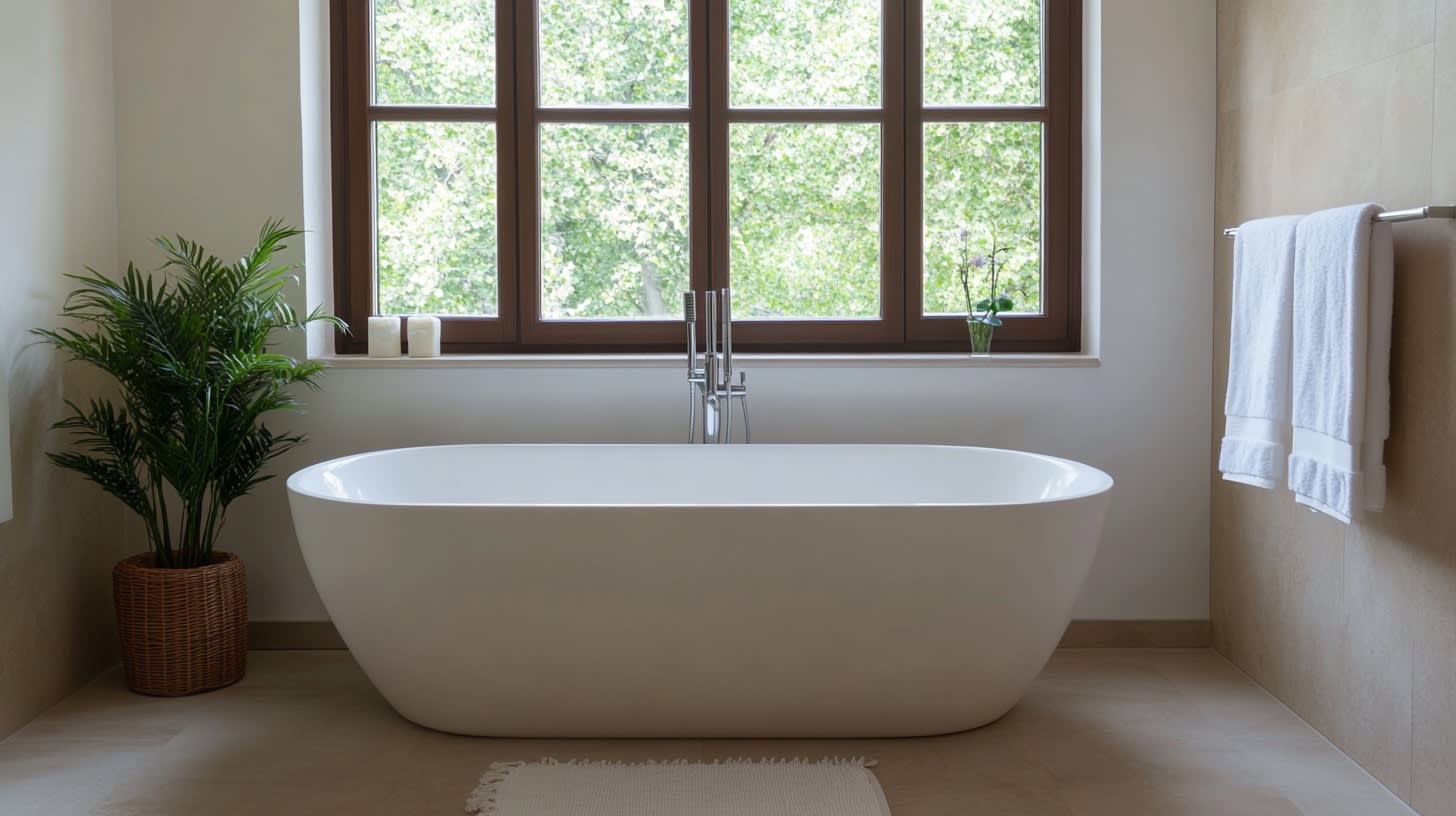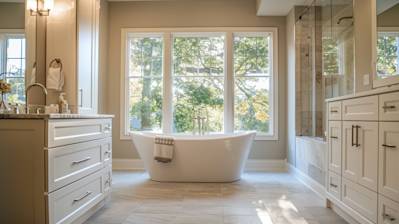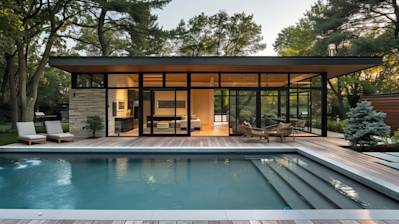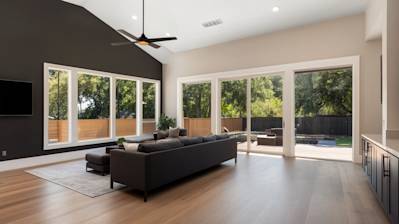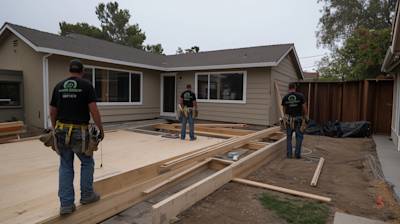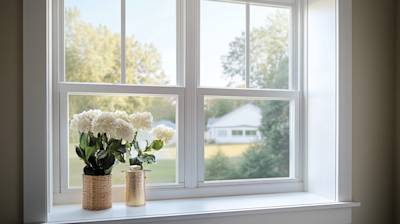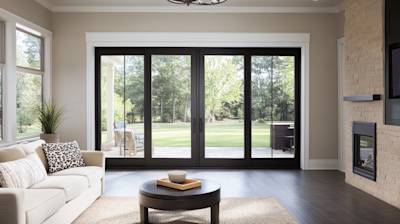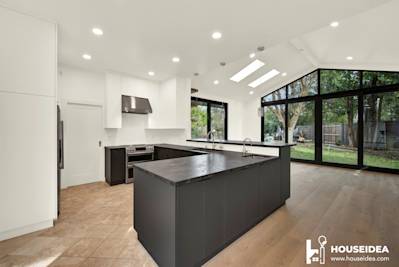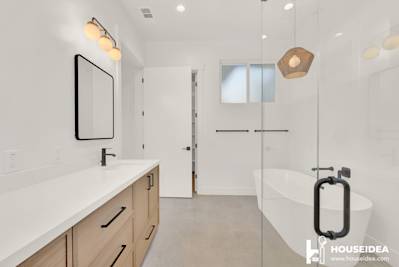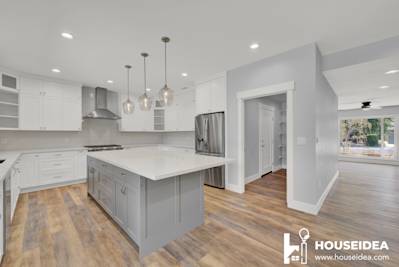Introduction
Luxury has a new synonym – free standing bathtubs. These are no longer simply porcelain vessels to clean ourselves in; they have transformed into mesmerizing masterpieces that offer a contemporary aesthetic and modern look to your bathroom. Adorned with lavish sophistication, recreational comfort, and unrivaled ambiance, they are now seen as symbols of opulence and tranquility.
This extensive guide will delve deep into this latest bathroom trend - free standing bathtubs, focusing on the factors behind their popularity, types, cost considerations, and installation requirements.
Fascination for Free Standing Bathtubs
Classy, practical, and versatile, the free standing bathtub imparts a stylish beauty that helps to create a bathroom retreat. Bold and beautiful, it stands independently and offers imposing flexibility regarding placement. Made from outstanding materials like acrylic, cast iron, and resin, they usher in an unwavering commitment to quality and finesse.
Key Distinctions of Free Standing Tub
- Independent Placement: Unlike traditional baths, a free standing bath can be placed anywhere in the bathroom. It lends space for architectural inventiveness.
- Breathtaking Aesthetics: The distinct and sculptural design of the free standing tub makes the bathroom visually impressive. They become centerpieces that command attention.
- Variety & Versatility: From traditional claw-footed tubs to sleek, modern designs - free standing bathtubs come in a wide assortment of styles, shapes, and sizes.
- Enhanced Depth & Comfort: Most free standing baths are deeper than regular ones, offering a deeper immersion experience. They provide extraordinary comfort and relaxation.
A Dive into Different Styles
There's a free standing bathtub to match every interior style. Let's jump into the world of varieties that these tubs offer.
Classic Clawfoot Tubs
With a classic vintage appeal, clawfoot tubs are the earliest form of free standing baths. Their timeless elegance and antique charm make them a popular choice for traditional, farmhouse, and vintage-inspired bathroom designs.
Modern Pedestal Tubs
Also known as skirted or apron front tubs, pedestal tubs are the modern twist to clawfoot tubs. They feature a base or pedestal which elevates the tub off the floor, creating a floating illusion that makes bathrooms look spacious and extravagant.
Slipper Tubs
Known for their high-backed design, slipper tubs are designed for ultimate comfort and lounging. They have one or sometimes both ends sweeping up for better back support. They are revered for their unique look and exquisite luxury.
Japanese Soaking Tubs
Japanese soaking tubs or "Ofuro" bathtubs deliver a deep, relaxing soak. They have a unique round, oval, or square shape and are typically deeper than other styles. These are perfect for minimalistic designs.
Investing in a Free Standing Tub – Cost Considerations
Free standing tubs generally cost more than built-in bathtubs due to their luxurious design and high-quality materials. Prices can vary significantly, depending mainly on the material and size of the tub. Although they come with a higher initial cost, they do provide a massive boost in your home’s resale value.
Installing a Free Standing Bathtub – What You Need to Know
Installation of a free standing tub, while straightforward, involves several factors:
- Plumbing: The tub’s plumbing must be tailored according to the tub's design and location. Wall-mounted or floor-mounted faucets may be required.
- Space: They need ample space around them for aesthetic appeal, ease of cleaning, and accessibility.
- Floor Strength: Considering their weight, especially when filled with water and the weight of a person, the floor strength should be evaluated.
Tub Material – The Heart of the Matter
Beneath the elegance of a free standing tub lies the heart of durable material. Here are some commonly used materials:
- Acrylic: Lightweight, warm to the touch, and available in a range of colors and designs.
- Cast Iron: Durable and retains heat very well but considerably heavy.
- Resin: A mixture of materials delivering a stone-like finish, excellent heat retention but moderately heavy.
Frequently Asked Questions about Free Standing Bath Tub
How is a free standing bath tub different from a built-in bathtub?
Unlike the traditional built-in bathtub that is fitted into a corner or against a wall, a free standing bath tub is designed to stand independently anywhere in the bathroom. It is not attached to the wall or corner and has finished sides all round, allowing more flexibility in terms of positioning.
Does a free standing bath tub have built-in features?
Depending on the model, a free standing bath tub can have various built-in features. Some models come with jets for a spa-like experience, while others include built-in loungers or handrails for added comfort and safety. It's always best to check with the manufacturer or supplier to find out about specific features.
What materials are free standing bath tubs made of?
Free standing bath tubs can be made from a wide range of materials. Some of the most common ones include acrylic, cast iron, enameled steel, copper, stone, and even wood. The choice of material can significantly affect the tub's weight, durability, heat retention capabilities, and aesthetic appeal.
Can a free standing bath tub fit in a small bathroom?
Yes, free standing bath tubs come in various sizes and shapes to accommodate a variety of bathroom dimensions. Even if your bathroom is small, you should be able to find a free standing tub that fits comfortably.
What is the typical cost of a free standing bath tub?
The cost of a free standing bath tub can vary widely depending on factors like size, material, brand, and built-in features. Typically, you might expect to pay anything from a few hundred dollars to several thousand dollars. Be sure to shop around to compare prices and features.
How do I clean a free standing bath tub?
The cleaning method for a free standing bath tub depends largely on its material. For most materials, mild non-abrasive cleaners and a soft sponge should work well. Always check with the tub's manufacturer or consult the user manual for specific cleaning instructions.
Can I install a shower over my free standing bath tub?
While it is possible to install a shower over a free standing bath tub, it may not be the best solution due to the tub's position in the bathroom and potential for water spillage. However, if you really need a shower/bath combination and a separate shower enclosure is not possible, there are shower curtain and screen options that can minimize the water splash.
Can a free standing bath tub have a built-in faucet?
Yes, many free standing bath tubs have built-in faucets. However, the faucet can also be mounted on the floor or wall, particularly for those tubs that do not come with pre-drilled faucet holes. Always check the specifics of your chosen tub and discuss options with your plumber.
Can I move my free standing bath tub once it is installed?
While theoretically possible, moving a free standing bath tub once it is fully installed and connected to the plumbing can be a complex task that requires professional assistance. If you anticipate needing to move the tub, consider this before finalizing its position during installation.
Pros of Free Standing Bath Tubs
Styling Options
Variety in Design
Free standing bath tubs come in a variety of designs, shapes, and sizes, creating an option for virtually every home decor style. From sleek and modern to classic and elaborate, there's a tub style to fit any user's preference.
Focal Point in a Bathroom
Free standing bath tubs can add a touch of luxury and act as a focal point in any bathroom. They are often used in master suites or spa-like bathrooms to provide a central point of attention. This can significantly enhance the overall aesthetic appeal of the space.
Versatility in Placement
Unlike built-in baths, free standing tubs are not confined to a specific location beside a wall or in a corner. This means they can be placed anywhere in the bathroom, giving the owner more control over the layout and design of the room.
Installation and Maintenance
Easier Installation
The installation process for a free standing bath tub can be simpler and less time-consuming compared to a built-in one. There's no need to build frames or platforms, or to install tiles around the tub.
Simplified Cleaning
The all-around access to a free standing bath makes it easier to clean, since you can reach every part of the tub. This accessibility can also have a positive impact on maintenance over time.
Cons of Free Standing Bath Tubs
Practical Considerations
Space Requirement
Free standing tubs often require more space than built-in ones. This may not be a problem in a large, luxurious bathroom, but it can be restrictive in smaller spaces where every inch counts.
Stability Issues
Due to their design, free standing tubs can occasionally be less stable than their built-in counterparts. This mostly depends on the quality of the tub and the installation, but it's something to consider if you have young kids or people with balance issues in your home.
Extra Plumbing Costs
As these tubs can be positioned in various places, plumbing can become more complex, leading to increased costs in some instances. Hidden plumbing connections and drains may require the work of a professional, adding to the overall installation expense.
Comfort and Functionality Aspects
No Storage Area
A free standing bath tub doesn't come with built-in shelves or corners for storing bath necessities. This can be inconvenient and may require the addition of a separate storage piece.
Harder Entry and Exit
Most free standing bathtubs are deeper than built-in tubs, meaning they can be harder to get in and out of, especially for children or individuals with mobility issues. Some models may require steps, which can also increase the risk of trips and falls.
Less Insulation
Free standing tubs, especially those made of materials like acrylic or fiberglass, may not retain heat as long as a built-in tub. This can result in a cooler bath during long soaks and can increase the need to continually add hot water to maintain the desired temperature.
Summary
Overall, upgrading your bathroom with a free-standing bathtub brings a unique design element that can't be overlooked. These bathtubs not only offer an oasis of relaxation in your bathroom, but also enhance the overall aesthetics. With a myriad of styles, sizes and materials available, there's a free-standing bathtub to match every décor and personal preference.
Why settle for an ordinary bathroom when you can create an extraordinary one with a free-standing bathtub? It serves as a focal point, churning your regular bathroom into a spa-inspired space. Looking beyond their visual appeal, these bathtubs are easy to install, offering great flexibility in terms of placement.
Taking an everyday activity like bathing and making it extraordinary, that's the power of a free-standing bathtub. Transform your daily rinse into a luxurious experience and your bathroom into a retreat. The perfect blend of style and function, a free-standing bathtub is a worthwhile investment for any homeowner.
About HouseIdea
At HouseIdea, based in the heart of Sacramento, CA, we're not just about houses - we passionately believe in creating a sense of 'home'. Our core principle revolves around transforming simple house spaces into inspiring and welcoming homes that resonate with your personal style. Leveraging years of experience in the field, our talented team brings innovation and charisma to every project, redefining the very essence of living spaces. Founded by a team of driven individuals who are enthusiasts of aesthetic living environments, our place is your go-to for imaginative solutions that blend function, comfort, and style. Trust us with your vision, and we'll make your home a true reflection of you.
Tags: bathroom, home decor, relaxation,


